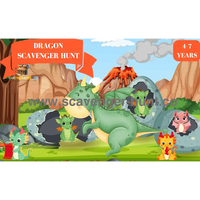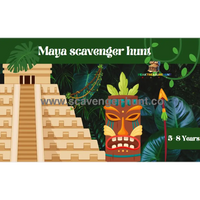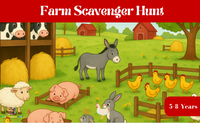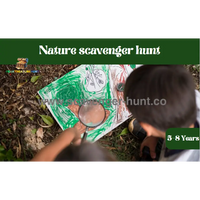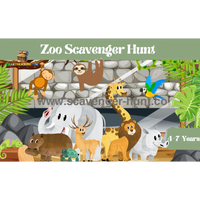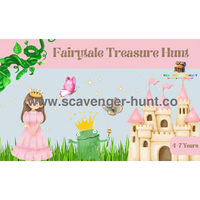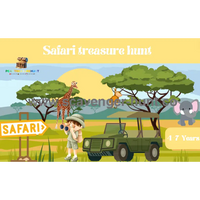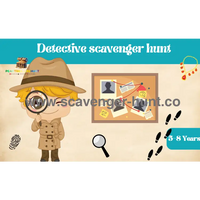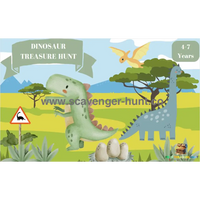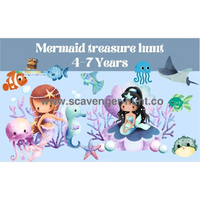🌳Journey Through the Green: Exciting Nature Scavenger Hunts For Young Explorers
Dear kids, are you ready for an adventure that lets you breathe fresh air and brings you closer to the secrets of nature? Then a nature scavenger hunt is just right for you! Imagine being brave explorers, roaming through forests, exploring meadows, and solving exciting puzzles along the way. A scavenger hunt in nature is not only a huge fun but also teaches you a lot about plants, animals, and how to survive in the wilderness. Pack your explorer hats and magnifying glasses, because we're embarking on an exciting journey through nature together!
Planning Your Nature Scavenger Hunt
Every great adventure starts with good planning. Think about which places nearby are exciting to explore. A nearby forest, a park, or even your own garden can be the perfect spot for your nature scavenger hunt. It's important that you always stay safe and respect the rules of nature.
Every great adventure starts with solid planning. Take some time to think about the exciting places around you that are ripe for exploration. A forest close to your home, a local park, or even your own backyard can provide the perfect setting for your nature scavenger hunt. The key is to ensure that wherever you choose is safe and that you respect the natural environment while on your quest.

Identifying the Ideal Location
Start by identifying areas that are not only safe but also rich in biodiversity. This could mean areas with a variety of plants, trees, insects, and possibly even wildlife. Remember, the goal is to find a place that offers a wide range of natural elements to explore and learn from.
Choosing the perfect setting for a nature scavenger hunt is a critical first step in ensuring a successful, educational, and enjoyable adventure for all participants. The ideal location serves as the living backdrop for the hunt, enriching the experience with its natural beauty and diversity. To select such a place, consider areas known for their safety and abundant biodiversity. These locations might include local parks, nature reserves, botanical gardens, or even certain sections of national forests that are accessible to the public.
When scouting for the right spot, look for environments that boast a diverse array of flora and fauna. The presence of various plant species, from towering trees to delicate underbrush, adds layers of discovery and learning opportunities. Areas that support a wide range of insects and wildlife further enhance the hunt, offering glimpses into the complex ecosystems that sustain them. Water bodies such as ponds, streams, or lakes within these areas can also introduce participants to aquatic plants and animals, broadening the scope of exploration.
In addition to biodiversity, consider the location's accessibility and navigability. The site should be easy for all participants to reach and move around in, with well-marked trails or paths that minimize the risk of getting lost while still allowing for exciting exploration. Facilities like restrooms, picnic areas, and first aid stations contribute to a comfortable and safe environment, especially for activities involving children.
Furthermore, the chosen location should have a range of microhabitats. This variety, from sunny clearings to shaded woodland areas, marshy lands to dry meadows, provides a richer scavenger hunt with a variety of items to find and observe. Each microhabitat can host different species of plants and animals, offering a more comprehensive educational experience about the local ecosystem.
Engaging with local conservation groups or park rangers can also provide valuable insights into the best areas for such activities. They can offer advice on the most interesting spots within a location, any permits required for group activities, and guidelines to ensure the conservation of the natural environment during your scavenger hunt.
Ultimately, the goal is to select a location that is not only safe and accessible but also serves as a vibrant, open-air classroom. It should be a place where participants can immerse themselves in the wonders of nature, fostering a deeper appreciation for the environment and its conservation. Through careful selection of the ideal location, a nature scavenger hunt can become an unforgettable adventure that educates, engages, and inspires all who take part.

Safety First
Safety should be your top priority. Make sure the area is suitable for children and free of hazards. If you're venturing into a forest or a larger park, it might be wise to visit the site beforehand to scout out any potential dangers, such as steep inclines, water bodies, or areas with overgrown vegetation that could hide obstacles.
When planning a nature scavenger hunt, prioritizing safety ensures that the adventure remains enjoyable and free from unforeseen risks for everyone involved, especially children. A meticulous approach to assessing and preparing the chosen location can significantly mitigate potential hazards, turning the event into a memorable and worry-free experience.
Pre-Scouting the Location: Conducting a preliminary visit to the scavenger hunt site is an essential step in the safety preparation process. This allows you to personally assess the terrain and identify any areas that may pose risks to participants. During this visit, pay close attention to natural features such as steep inclines, which could lead to falls or injuries, and water bodies like ponds, streams, or lakes, where children should be closely supervised to prevent accidents.
Identifying and Addressing Hazards: Be on the lookout for areas with overgrown vegetation, as these can not only obscure the path but also hide obstacles such as rocks, holes, or roots that might cause trips and falls. Additionally, consider the presence of potentially harmful plants (like poison ivy or oak) or wildlife (such as bees or snakes), and plan your scavenger hunt route to avoid these dangers. Marking hazardous zones clearly or setting boundaries away from these areas can help keep participants safe.
Weather Considerations: Weather conditions can change rapidly, especially in natural settings. Check the forecast for the day of your event and plan accordingly. In case of adverse weather conditions like heavy rain, thunderstorms, or extreme heat, have a backup plan or be prepared to reschedule the scavenger hunt to ensure participants' safety.
Emergency Preparedness: Equip yourself and any other supervising adults with a basic first aid kit for handling minor injuries. Familiarize yourself with the closest medical facilities to the scavenger hunt location. Additionally, ensure that all participants and their guardians are aware of a designated meeting spot in case anyone gets separated from the group.
Supervision and Communication: Maintaining a suitable adult-to-child ratio is crucial for closely monitoring all participants and providing immediate assistance if needed. Equipping each group with whistles or two-way radios can enhance communication over distances, especially in areas where cell phone reception might be unreliable.
By embedding safety into the core of your nature scavenger hunt planning, you create a secure environment where children can freely explore and learn from the natural world around them. This precautionary approach allows participants to focus on the excitement and educational value of the adventure, making it an enriching experience for everyone involved.

Respecting Nature
Teaching children to respect nature is a valuable lesson. Remind everyone participating in the scavenger hunt to observe without disturbing. This means not picking flowers or leaves, not disturbing wildlife, and certainly not leaving any trash behind. It's all about leaving no trace and ensuring that the natural area remains as untouched as possible for others to enjoy.
Instilling a deep respect for nature in young minds is one of the most profound lessons that can be shared during activities like a scavenger hunt. It's essential to communicate the importance of interacting with the environment in a way that preserves its beauty and integrity for future generations. Here are some key principles to emphasize:
Observe Without Disturbing: Encourage participants to adopt a 'look but don't touch' approach when it comes to nature. Explain the significance of observing wildlife from a distance to avoid causing them stress or harm. Similarly, stress the importance of leaving plants, flowers, and natural structures as they are, so they can continue to grow and serve their ecological purpose.
Leave No Trace: The Leave No Trace principles are a cornerstone of respectful outdoor conduct. Teach children and participants about the importance of leaving the environment exactly as they found it. This includes packing out all trash, not picking plants or flowers, and avoiding the creation of new trails or paths that could contribute to erosion or habitat disruption.
Respect Wildlife: Wildlife should be admired from a distance. Remind scavenger hunt participants that animals are not to be fed, chased, or disturbed in any way. Explain how human interaction can negatively affect animals' natural behaviors and health.
Minimize Impact: Discuss how even small actions can have a significant impact on the environment. Encourage participants to stick to established trails to protect undergrowth and habitat, and to avoid loud noises that could disturb both wildlife and other visitors.
Promote Stewardship: Use the scavenger hunt as an opportunity to foster a sense of stewardship among participants. Encourage them to pick up litter they might find along the way (safely, and with adults handling any potentially dangerous items), and discuss how such actions contribute to the preservation of natural spaces.
Cultivate Appreciation: Beyond simply teaching respect, strive to cultivate a genuine appreciation for the natural world. Share interesting facts about the local ecosystem, point out unique plant species or animal behaviors, and encourage questions and curiosity. An appreciation for nature’s intricacies can inspire lifelong respect and care.
By embedding these principles into the scavenger hunt experience, you not only provide an entertaining and educational activity but also impart valuable lessons on environmental responsibility. Teaching children to respect and protect nature ensures they understand their role in conservation and encourages them to be mindful of their impact on the world around them.

Creating Your Scavenger Hunt List
Once you've chosen your location, create a scavenger hunt list tailored to the environment. This list can include items to find, tasks to complete, and questions to answer about the natural surroundings. For example, you might include finding a certain type of leaf, identifying bird calls, or completing a rubbing of tree bark.
Crafting your scavenger hunt list is a pivotal step in bringing the adventure to life, especially once you've pinpointed the perfect natural setting for your exploration. This list is your roadmap, guiding participants through a carefully curated journey of discovery, learning, and engagement with the environment. Here's how to create a scavenger hunt list that is both enriching and enjoyable:
Consider the Environment
Tailor your list to the specific features of your chosen location. If your hunt is in a woodland area, focus on items and tasks that highlight the forest's unique attributes. For a beach setting, include elements that are specific to coastal environments. This ensures that your scavenger hunt is relevant and deeply integrated with the natural setting.
Variety is Key
Incorporate a diverse range of activities to cater to different interests and ages:
-
Find Items: List natural objects to find, such as a feather, a smooth pebble, or a pinecone. Encourage respectful observation and discourage removing anything from its natural setting.
-
Tasks to Complete: Include interactive tasks like making a bark rubbing, building a small rock cairn, or sketching a flower. These activities encourage creativity and a deeper connection with nature.
-
Questions to Answer: Pose questions that prompt participants to observe closely or think critically about their surroundings. Questions could range from "Why do you think leaves change color?" to "Can you find a plant that insects seem to like?"
-
Identify Sounds or Smells: Challenge participants to identify specific bird calls, the sound of moving water, or the scent of pine. This engages senses beyond sight and fosters a holistic nature experience.
Educational Opportunities
Seize the chance to embed learning moments within your scavenger hunt. Include tasks that require participants to identify different types of trees, plants, or animal tracks. This not only adds an educational layer to the activity but also promotes environmental awareness and appreciation.
Encourage Observation and Respect
Make it clear that the goal is to explore and learn without disturbing the natural habitat. Instead of picking flowers or capturing insects, ask participants to take photos or simply observe and note their findings. This approach teaches respect for nature while still allowing for a comprehensive exploration of the environment.
Use Creative Clues and Descriptions
Engage participants with creatively written clues or riddles that lead them to the next item or task. This adds an element of mystery and excitement to the scavenger hunt, making the discovery process even more rewarding.
Safety and Accessibility
Ensure that all items on your list are accessible and safe for participants to attempt. Avoid including anything that might lead to hazardous areas or require risky behavior.
Final Touches
Once your list is complete, format it in an engaging and readable way. Consider including images or icons for younger participants who may not be reading yet. Print your lists on durable material if possible, especially if participants will be exploring areas where the lists might get wet or dirty.
Creating a thoughtful and well-constructed scavenger hunt list can transform a simple walk in nature into an unforgettable adventure. By encouraging exploration, observation, and respect for the environment, you'll provide participants with a meaningful experience that deepens their connection to the natural world.

Preparing for the Day
Ahead of the scavenger hunt, pack any necessary equipment you might need. This includes magnifying glasses for examining small insects or plant details, notebooks for jotting down observations, and cameras or smartphones for taking photos (a great way to capture findings without physically taking anything from nature). Also, ensure everyone dresses appropriately for the weather and terrain, wearing sturdy shoes and bringing along sunscreen, hats, and water.
Preparing adequately for the day of the scavenger hunt is crucial to ensuring that the adventure is not only enjoyable but also comfortable and safe for all participants. Proper preparation allows everyone to fully engage with the activities without the day being cut short due to unforeseen needs or discomforts. Here’s a comprehensive checklist to help you gear up for an unforgettable day of exploration and discovery:
Essential Gear
-
Magnifying Glasses: These are invaluable for up-close examination of the intricate details of nature, be it the pattern on a leaf, the texture of bark, or the delicate features of an insect.
-
Notebooks and Pencils: Encourage participants to bring along notebooks or sketchpads and pencils for jotting down observations, drawing what they see, or solving puzzles included in the scavenger hunt list.
-
Cameras or Smartphones: Utilizing cameras or smartphones allows participants to document their findings through photographs. This is especially important for capturing evidence of items found during the hunt while adhering to the principle of leaving no trace in nature.
-
Reusable Water Bottles: Staying hydrated is key, especially on warm days or during physically active hunts. Encourage every participant to carry a water bottle, and plan for refills if necessary.
Appropriate Attire
-
Weather-Appropriate Clothing: Check the weather forecast and advise participants to dress accordingly. Layering can be particularly effective for fluctuating temperatures.
-
Sturdy Footwear: Recommend wearing comfortable, durable shoes suitable for walking or hiking in the chosen environment. Proper footwear can prevent slips, falls, and discomfort.
-
Sun Protection: Sunscreen, hats, and sunglasses are essential for sunny days to protect against sunburn and heat exhaustion.
-
Insect Repellent: Depending on the location and time of year, an insect repellent can keep bothersome bugs at bay, making the experience more pleasant for everyone.
Additional Considerations
-
First Aid Kit: Always have a basic first aid kit on hand for treating minor scrapes, cuts, or insect bites. Include items like band-aids, antiseptic wipes, and allergy medication.
-
Snacks: Pack light, energy-boosting snacks such as fruit, nuts, or granola bars to keep energy levels up throughout the adventure.
-
Weather Protection: Depending on the forecast, you might need additional items like raincoats, umbrellas, or extra layers for warmth.
-
Backpacks or Bags: Ensure that participants have a comfortable way to carry their personal items, equipment, and any collected trash until it can be properly disposed of.
By meticulously preparing for the day, you set the stage for a seamless and enriching scavenger hunt experience. Not only does this preparation foster a sense of adventure, but it also demonstrates a commitment to safety, respect for nature, and consideration for the well-being and comfort of all participants. With everything in place, participants can immerse themselves in the joy of discovery and the beauty of the natural world around them.

Involving Participants in the Planning
Engage children in the planning process by asking them what they would like to discover during the scavenger hunt. This not only increases their excitement and anticipation for the adventure but also gives them a sense of ownership over the activity.
Involving participants, especially children, in the planning stages of a scavenger hunt can significantly enhance their engagement and enjoyment of the event. By incorporating their ideas and interests into the scavenger hunt, children gain a vested interest in the activity, transforming it from a mere game into a personalized adventure they helped create. Here’s how to effectively involve them in the planning process:
Brainstorming Session
Initiate a brainstorming session where children can freely express their curiosity and interests. Ask them about the natural elements, animals, or environmental features they are excited to learn more about. This could range from wanting to identify different types of leaves to spotting various bird species or exploring insect habitats.
Creating the List Together
Use the ideas gathered from the brainstorming session to start drafting the scavenger hunt list. Allow children to suggest specific items to find or tasks to complete. For example, if a child is interested in flowers, include a task to identify a certain number of flower types. This collaborative approach ensures the scavenger hunt reflects their genuine interests.
Designing Clues and Challenges
Encourage children to help design some of the clues or challenges. This could involve simple riddles leading to the next location or creative tasks that reflect their imagination. Their involvement in this creative process not only makes the scavenger hunt more engaging for them but also encourages them to think critically and creatively.
Decision-Making
Involve children in making decisions about various aspects of the scavenger hunt, such as choosing the location (if options are available), selecting a theme, or deciding on the types of rewards. Giving them a say in these decisions fosters a sense of responsibility and leadership.
Preparing Materials
Engage children in preparing materials for the scavenger hunt, such as decorating the scavenger hunt lists or assembling the treasure chest. This hands-on involvement allows them to contribute tangibly to the preparation, increasing their anticipation and investment in the event.
Educational Aspects
Discuss with children what they hope to learn from the scavenger hunt. Incorporating educational goals, they're interested in—like learning about plant life cycles or understanding how to use a compass—can make the scavenger hunt an enriching learning experience.
By actively involving participants in the planning process, you empower them to take ownership of the scavenger hunt, ensuring it becomes a deeply personal and eagerly anticipated adventure. This inclusive approach not only heightens their excitement and engagement but also fosters a deeper connection to nature and an appreciation for collective planning and teamwork. Through their involvement, the scavenger hunt becomes more than just a game—it becomes a journey of discovery, crafted by their own hands and imaginations.

Conclusion
A well-planned nature scavenger hunt can be an enlightening and enjoyable way to connect with the natural world. By choosing the right location, ensuring safety, respecting the environment, and preparing a thoughtful scavenger hunt list, you're setting the stage for an educational and fun-filled adventure. Remember, the ultimate goal is to spark curiosity and foster a lifelong appreciation for nature among the young explorers.
Involving participants, especially children, in the planning process of a nature scavenger hunt is a valuable approach that enhances the overall experience. When children are asked about their interests and what they wish to discover or learn during the scavenger hunt, it not only heightens their excitement and anticipation but also imbues them with a sense of ownership and responsibility towards the activity. This inclusive planning process encourages them to think creatively and express their natural curiosities, ensuring that the scavenger hunt resonates with their personal interests and ignites their enthusiasm for exploration.
By actively participating in the planning stages, children can suggest items they’re curious about, from specific types of leaves to wildlife they hope to spot. This collaborative approach allows for the creation of a scavenger hunt list that is not only educational but also tailored to captivate the imaginations of the young participants. Furthermore, involving them in discussions about safety, respect for nature, and the importance of leaving no trace teaches valuable lessons in environmental stewardship and responsibility.
This method of planning not only prepares children for the adventure ahead but also cultivates skills in teamwork, decision-making, and problem-solving. It transforms the scavenger hunt from a simple game into a meaningful journey of discovery that they have helped to shape.
A nature scavenger hunt, thoughtfully orchestrated with attention to location, safety, environmental respect, and participant engagement, offers a unique and enriching opportunity to connect with the wonders of the natural world. By meticulously preparing and incorporating the insights and enthusiasms of the young explorers themselves, you lay the groundwork for an adventure that is both educational and immensely enjoyable. The true essence of a successful scavenger hunt lies in its ability to spark curiosity, inspire awe, and foster a lifelong appreciation for the beauty and complexity of nature. Through this immersive experience, children are not just participants but active learners and budding environmental stewards, embarking on a journey that nurtures their love for exploration and the natural world around them.

Puzzles and Tasks Nature Sets for You
Your nature scavenger hunt should include exciting puzzles and tasks. How about identifying tracks of wild animals or recognizing different types of trees? You could also create a treasure map that leads you to hidden natural wonders.
Incorporating puzzles and tasks into your nature scavenger hunt transforms a simple walk in the outdoors into an interactive and educational adventure. By engaging with the natural world through these challenges, participants deepen their connection with the environment, enhance their observational skills, and learn valuable knowledge about their surroundings. Here are some ideas to enrich your scavenger hunt with intriguing puzzles and tasks:
Identifying Animal Tracks
Challenge participants to become wildlife detectives by identifying animal tracks found along the trail. Provide a guide or pictures of common local animal footprints and ask them to match what they find on the ground. This task encourages careful observation and teaches participants about the animals that inhabit the area.
Recognizing Tree Species
Equip your scavenger hunters with a simple guide to the leaves or bark of different trees and set them the task of identifying various species. This not only fosters a deeper appreciation for the diversity of the forest but also educates them on the ecosystem's complexity and the importance of conservation.
Solving Natural Riddles
Create riddles that lead participants to discover specific natural features, such as a peculiar rock formation, a unique tree, or a hidden stream. For example, "I stand tall and reach to the sky, losing my coat when it's cold by and by. What am I?" The answer, a tree that sheds its leaves in autumn, guides them to their next destination.
Creating a Treasure Map
Design a treasure map that incorporates natural landmarks and leads participants on a journey to discover hidden natural wonders. The 'treasure' could be a breathtaking view, a secluded spot filled with wildflowers, or a secret grove. This task encourages exploration and instills a sense of adventure, making the journey itself the reward.
Eco-Friendly Challenges
Include tasks that promote environmental stewardship, such as photographing various types of insects without disturbing them, collecting litter along the trail (while wearing gloves), or identifying signs of healthy versus unhealthy ecosystems. These activities raise awareness about human impact on nature and the importance of preserving our natural habitats.
Observational Bingo
Create a bingo card filled with items or phenomena to observe in nature, such as a bird in flight, a squirrel climbing a tree, or a cloud shaped like an animal. This playful task turns observation into a game, encouraging participants to stay alert and engaged with their surroundings.
By blending the beauty and diversity of the natural world with the thrill of discovery through puzzles and tasks, a nature scavenger hunt becomes a meaningful and memorable learning experience. It's an opportunity to nurture curiosity, respect for nature, and a sense of wonder that participants will carry with them long after the adventure ends.

Equipment for Young Nature Researchers
You'll need the right equipment for a nature scavenger hunt. A magnifying glass to take a closer look at insects and plants, a notebook for your discoveries, and of course, a treasure map. Don't forget to bring weather-appropriate clothing and enough water.
Equipping young nature researchers with the right tools is essential for a successful and enriching nature scavenger hunt experience. By providing them with the necessary equipment, you not only enhance their ability to explore and discover but also ensure their comfort and safety throughout the adventure. Here's a list of must-have items for your young explorers:
Magnifying Glass
A magnifying glass is a valuable tool for any nature scavenger hunt. It allows participants to examine the intricate details of leaves, insects, and small creatures up close, turning a casual observation into a fascinating discovery. This simple tool can spark curiosity and a deeper appreciation for the complexity of the natural world.
Notebook and Pencils
Equipping young researchers with a durable notebook and pencils gives them a place to jot down their observations, sketch plants and animals they encounter, or solve puzzles and riddles included in the scavenger hunt. Encouraging note-taking and drawing not only aids in learning but also helps children process and remember their discoveries.
Treasure Map
A well-crafted treasure map adds an element of excitement and mystery to the scavenger hunt. It guides participants through their exploration, leading them to specific landmarks or hidden "treasures" in the natural environment. The map can include symbols, landmarks, and clues, making the journey an engaging quest that stimulates problem-solving and navigation skills.
Weather-Appropriate Clothing
The outdoors can be unpredictable, so it's important to dress appropriately for the weather. Lightweight, breathable clothing is ideal for warm days, while layers are key for cooler weather. Waterproof jackets or ponchos can protect against unexpected rain showers. Durable, comfortable footwear is also crucial for navigating various terrains safely.
Water Bottle
Staying hydrated is essential, especially during physical activities like a scavenger hunt. Provide each participant with a reusable water bottle and encourage regular water breaks. This not only keeps everyone hydrated but also promotes environmental responsibility by reducing the use of disposable plastic bottles.
Optional Items for Enhanced Exploration
-
Binoculars: Great for bird watching or observing wildlife from a distance.
-
Camera or Smartphone: Ideal for capturing photos of discoveries without disturbing the environment.
-
Compass or GPS Device: Useful for teaching basic navigation skills and orienteering.
-
Insect Repellent: Non-toxic, environmentally friendly options can help keep pesky bugs at bay.
-
First Aid Kit: Essential for addressing minor injuries, scrapes, or insect bites.
By preparing young nature researchers with the right equipment, you set the stage for a fulfilling and educational outdoor adventure. This preparation not only ensures participants can fully engage with their surroundings but also highlights the importance of respect for nature and personal responsibility. A well-equipped scavenger hunt is an opportunity for children to learn, explore, and develop a lifelong love for the natural world.

Learning and Fun in Nature
During your scavenger hunt, you'll learn a lot about nature. Every plant and animal has its own story. Perhaps you'll also discover how important it is to protect our environment. The best part? You'll have lots of fun outdoors and can prove your teamwork skills.
Embarking on a nature scavenger hunt is not just an outdoor adventure; it's a gateway to a world of learning and discovery, all while having a tremendous amount of fun. As you navigate through the wilderness, city park, or even your backyard, every leaf turned and every path taken holds a lesson about the natural world and our place within it. Here's how a nature scavenger hunt blends education, environmental awareness, and enjoyment:
Uncovering the Stories of Nature
Each element of nature, from the towering trees to the smallest insects, carries its own unique story. Through the tasks and challenges of a scavenger hunt, participants learn about the roles different plants and animals play in their ecosystems, their adaptations for survival, and their relationships with each other. This hands-on learning experience can ignite a passion for biology, ecology, and botany among young explorers.
Emphasizing Environmental Conservation
One of the most profound lessons a nature scavenger hunt can impart is the importance of protecting our environment. By engaging directly with nature, participants can see firsthand the beauty of the natural world and understand the threats it faces. Activities that encourage observation and interaction without disturbance teach respect for wildlife and the need for conservation efforts to preserve these environments for future generations.
The Joy of Outdoor Fun
There's something inherently joyful about spending time outdoors, and a nature scavenger hunt capitalizes on this by turning environmental exploration into a game. The excitement of finding a hidden item or solving a nature-related puzzle adds an element of play that makes learning feel like an adventure. This outdoor fun fosters a healthy lifestyle, encouraging physical activity and appreciation for the simple pleasures found in nature.
Building Teamwork Skills
A nature scavenger hunt is also an excellent opportunity for participants to prove and improve their teamwork skills. Whether working in pairs or small groups, children and adults alike learn to communicate effectively, collaborate on solving tasks, and support one another throughout the adventure. These teamwork experiences are valuable life lessons, teaching participants about leadership, cooperation, and mutual respect.
A nature scavenger hunt is a multifaceted experience that combines education, environmental stewardship, outdoor enjoyment, and teamwork. It's an opportunity to learn about the intricate stories that make up our natural world, the critical importance of protecting this treasure, and the joy of discovering its wonders together. So, gather your team, step outside, and prepare to embark on a journey that will leave you with a deeper understanding of nature, lasting memories of fun, and a strengthened bond with your fellow explorers.

Creating Memories That Last
After your nature scavenger hunt, you'll not only be smarter but also have unforgettable memories. Maybe you'll craft a little souvenir from the natural materials you found, or you'll keep a diary of your adventures.
A nature scavenger hunt is much more than a day's activity; it's a journey into the heart of the natural world that leaves you richer in knowledge and experiences. But beyond the immediate thrill of discovery and the lessons learned along the way, it's the memories created that truly endure. These memories become treasures of their own, cherished long after the day has faded. Here are ways to ensure those memories last and continue to inspire:
Crafting Souvenirs from Nature
Imagine turning a smooth stone found on the path or a fallen leaf with a unique pattern into a keepsake. With creativity and respect for nature (ensuring you only use materials that have already fallen to the ground), you can craft souvenirs that hold the essence of your adventure. Whether it's a bookmark made from leaves, a painted stone to adorn your desk, or a simple woven bracelet of twigs and yarn, these natural souvenirs serve as tangible reminders of your journey and the wonders you encountered.
Keeping an Adventure Diary
Documenting your scavenger hunt in an adventure diary is another wonderful way to capture the memories. Encourage participants to jot down their observations, sketch the plants or animals they found intriguing, and note the challenges they overcame. This diary becomes a personal account of the adventure, filled with details that might otherwise fade over time. Photos taken during the hunt can be printed and added to the diary, creating a visual and written record that brings the experience to life again with every page turn.
Sharing Stories
The stories that emerge from a nature scavenger hunt are perhaps the most enduring memories of all. Sharing tales of the day's discoveries, the puzzles solved, and the sights and sounds of nature helps to relive the excitement and joy of the hunt. These stories, passed among friends and family or shared at future gatherings, keep the spirit of the adventure alive and may even inspire others to embark on their own nature explorations.
Reflection and Appreciation
In the quiet moments after the scavenger hunt, reflecting on the day can deepen the appreciation for the experience and the natural world. Discussing what was learned, the beauty observed, and how the adventure changed perceptions of the environment can solidify the day's experiences into lasting memories. This reflection can also reinforce the importance of nature conservation and the role each individual plays in protecting our planet.
The memories made during a nature scavenger hunt extend far beyond the event itself, becoming an integral part of how we view and interact with the natural world. Through crafted souvenirs, adventure diaries, shared stories, and moments of reflection, the experiences of the scavenger hunt live on, enriching lives with a deeper connection to nature and an enduring sense of wonder and discovery.

Frequently Asked Questions
-
What should I wear? Wear weather-appropriate clothing and sturdy shoes so you can safely walk through nature.
-
What if I find something dangerous in nature? Always stick together and call an adult if you find something that could be dangerous.
-
Can I take plants or animals home with me? It's best to leave everything in nature where you found it. This way, you can ensure that the next explorer experiences the same joy.
-
How can I prepare for a nature scavenger hunt? Learn a little about the nature in your area and think about what you'd like to discover. Good preparation makes the adventure even more exciting.
-
What to do if we get lost? Make sure an adult is always with you and stick to the plan you made before the scavenger hunt.

Summary
A nature scavenger hunt is more than just a game; it's a journey that teaches you to appreciate nature while having fun with friends or family. You'll not only expand your knowledge of the environment but also learn to work as a team and overcome challenges together. Now that you know all about planning and conducting such a scavenger hunt, it's time to start your own adventure. Always remember to respect nature and stay safe. Ready, set, adventure in nature!
After the excitement of a nature scavenger hunt, participants come away enriched with knowledge, team spirit, and a collection of unforgettable memories that will last a lifetime. The adventure might end, but its impact lingers, inspiring a deeper connection with the natural world and with each other. To immortalize the day's experiences, consider creating tangible mementos or keeping a detailed diary of your discoveries and challenges overcome. Crafting souvenirs from natural materials found during the hunt (while being mindful of conservation practices) or documenting the journey in a diary can serve as lasting reminders of the adventure and the lessons learned along the way.
A nature scavenger hunt transcends the notion of a mere game. It emerges as a meaningful journey that nurtures an appreciation for the natural world, all while engaging in joyful exploration with friends or family. This unique adventure not only broadens your environmental understanding but also hones teamwork and problem-solving skills as you navigate challenges together. Armed with insights on how to meticulously plan and execute such an escapade, you're well-prepared to embark on your own expedition. As you step into the wilderness, remember the importance of respecting nature's delicate balance and prioritizing safety in every adventure. With enthusiasm and preparation, it's time to dive into the wonders of nature. Ready, set, let the adventure begin!





